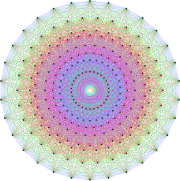Our website is made possible by displaying online advertisements to our visitors.
Please consider supporting us by disabling your ad blocker.
Euclidean group
| Algebraic structure → Group theory Group theory |
|---|
 |
| Lie groups and Lie algebras |
|---|
 |
In mathematics, a Euclidean group is the group of (Euclidean) isometries of a Euclidean space ; that is, the transformations of that space that preserve the Euclidean distance between any two points (also called Euclidean transformations). The group depends only on the dimension n of the space, and is commonly denoted E(n) or ISO(n), for inhomogeneous special orthogonal group.
The Euclidean group E(n) comprises all translations, rotations, and reflections of ; and arbitrary finite combinations of them. The Euclidean group can be seen as the symmetry group of the space itself, and contains the group of symmetries of any figure (subset) of that space.
A Euclidean isometry can be direct or indirect, depending on whether it preserves the handedness of figures. The direct Euclidean isometries form a subgroup, the special Euclidean group, often denoted SE(n) and E+(n), whose elements are called rigid motions or Euclidean motions. They comprise arbitrary combinations of translations and rotations, but not reflections.
These groups are among the oldest and most studied, at least in the cases of dimension 2 and 3 – implicitly, long before the concept of group was invented.
Previous Page Next Page




